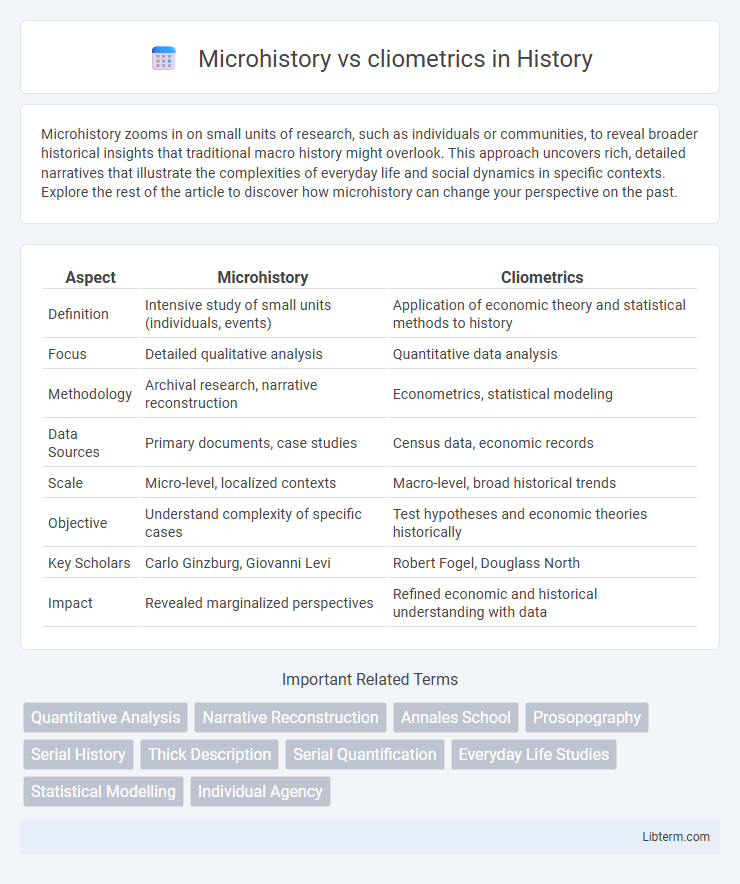Microhistory zooms in on small units of research, such as individuals or communities, to reveal broader historical insights that traditional macro history might overlook. This approach uncovers rich, detailed narratives that illustrate the complexities of everyday life and social dynamics in specific contexts. Explore the rest of the article to discover how microhistory can change your perspective on the past.
Table of Comparison
| Aspect | Microhistory | Cliometrics |
|---|---|---|
| Definition | Intensive study of small units (individuals, events) | Application of economic theory and statistical methods to history |
| Focus | Detailed qualitative analysis | Quantitative data analysis |
| Methodology | Archival research, narrative reconstruction | Econometrics, statistical modeling |
| Data Sources | Primary documents, case studies | Census data, economic records |
| Scale | Micro-level, localized contexts | Macro-level, broad historical trends |
| Objective | Understand complexity of specific cases | Test hypotheses and economic theories historically |
| Key Scholars | Carlo Ginzburg, Giovanni Levi | Robert Fogel, Douglass North |
| Impact | Revealed marginalized perspectives | Refined economic and historical understanding with data |
Introduction to Microhistory and Cliometrics
Microhistory focuses on detailed examination of small units like individuals or communities to uncover broader historical insights through qualitative analysis. Cliometrics employs quantitative methods, using statistical data and economic theory to analyze historical phenomena and test hypotheses. Both approaches offer complementary perspectives: microhistory emphasizes narrative depth and contextual understanding, while cliometrics prioritizes rigorous data-driven analysis in historical research.
Defining Microhistory: Focus and Methods
Microhistory centers on detailed examination of specific individuals, events, or communities to uncover broader historical insights, employing qualitative methods such as archival research, personal narratives, and local records. This approach contrasts with cliometrics, which utilizes quantitative data, statistical models, and economic theory to analyze historical trends and patterns on a large scale. Microhistory's focus on granular, context-rich storytelling offers depth and nuance absent in cliometric aggregation.
Understanding Cliometrics: Quantitative History Explained
Cliometrics applies quantitative methods, including statistical analysis and economic theory, to interpret historical data, enhancing the empirical rigor of economic and social history. Microhistory focuses on detailed, contextual narratives of small units, like individual lives or communities, contrasting with cliometrics' emphasis on broad data sets and econometric techniques. Understanding cliometrics involves recognizing its role in transforming history through measurable, data-driven insights into historical economic patterns and societal trends.
Origins and Development of Microhistory
Microhistory originated in the 1970s primarily in Italy, emerging as a reaction against broad quantitative methods like cliometrics that emphasized large-scale economic and social data analysis. Pioneers like Carlo Ginzburg focused on intensive case studies of individuals or small communities to uncover detailed, nuanced historical realities often neglected by cliometric approaches. This methodological shift prioritized qualitative depth and the reconstruction of everyday experiences over statistical generalization.
The Rise of Cliometrics in Historical Research
The rise of cliometrics revolutionized historical research by integrating quantitative methods and economic theory to analyze historical data systematically. This approach contrasts with microhistory's focus on detailed, qualitative narratives of specific individuals or events, emphasizing broad trends and statistical evidence instead. Cliometrics has gained prominence due to its ability to uncover patterns in economic history and sociopolitical changes by leveraging large datasets and econometric models.
Methodological Differences: Qualitative vs Quantitative
Microhistory emphasizes qualitative analysis, focusing on detailed case studies and rich narratives to uncover individual experiences within historical contexts. Cliometrics applies quantitative methods, using statistical models and economic data to analyze broad historical trends objectively. This methodological divergence highlights microhistory's interpretive depth versus cliometrics' empirical precision in historical research.
Influential Works in Microhistory and Cliometrics
Influential works in microhistory, such as Carlo Ginzburg's *The Cheese and the Worms*, utilize detailed case studies to reveal broader historical patterns through the lens of individual experiences. In contrast, seminal cliometric texts like Robert Fogel's *Time on the Cross* apply quantitative methods and economic theory to analyze historical data, transforming economic history with rigorous statistical models. Together, these approaches highlight microhistory's emphasis on narrative depth and cliometrics' focus on data-driven analysis within historical scholarship.
Case Studies: Microhistorical vs Cliometric Approaches
Microhistory emphasizes detailed case studies of specific individuals or communities to uncover deeper social, cultural, and historical nuances, often relying on qualitative sources such as diaries, court records, and letters. Cliometric approaches use quantitative methods and statistical analysis of large datasets, such as census records and economic data, to identify broad patterns and test hypotheses in economic and social history. Case studies in microhistory reveal context-specific insights often missed by cliometric generalizations, while cliometrics enables the examination of macro-level trends across extensive temporal and spatial scales.
Strengths and Limitations of Each Approach
Microhistory excels in providing detailed, context-rich insights into individual experiences and localized events, revealing nuanced social dynamics often overlooked by broader analyses. Cliometrics applies quantitative methods and economic theory to history, enabling the identification of large-scale patterns and causal relationships through statistical data analysis. However, microhistory can lack generalizability due to its narrow focus, while cliometrics may oversimplify complex human behavior by relying heavily on available quantitative data and assumptions.
The Future of Historical Analysis: Integration or Divergence?
Microhistory's emphasis on detailed, localized narratives contrasts sharply with cliometrics' reliance on quantitative methods and economic modeling, creating a dynamic tension in future historical analysis. Integration of microhistorical insights with cliometric techniques promises richer, multidimensional understanding, leveraging big data while preserving contextual depth. The trajectory likely involves hybrid methodologies, where computational tools enhance qualitative research, fostering convergence rather than divergence in historiography.
Microhistory Infographic

 libterm.com
libterm.com